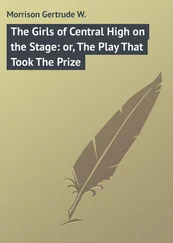“Find some paper,” Jessie told him. She began skimming her first book. “Does ‘Hoyt, S.’ count?”
“Yes,” said Henry, taking out the note they found in the comic book. “His name is Sid, but you might see ‘Hoyt, Sidney,’ too. Sid is usually short for Sidney.”
The children were silent as they leafed through one book after the other.
Then Violet jumped up in excitement. “Bingo! I bet this is him!”
The others leaned in to read the entry.
“‘Hoyt, Sid, 145 Oak Tree Circle, Putnam,’” Violet read aloud.
Jessie nodded. “I found a ‘Hoyt, S.’ in this book, but your Sid sounds like he’s the one.” She carefully copied the information, including the man’s phone number, on a piece of paper Benny found.
“Where is Putnam?” Violet wanted to know.
“I went to Putnam with Grandfather once,” Henry said. “It’s only about thirty minutes from Greenfield. What a lucky break for us!”
“Can we ride there on our bikes?” Benny asked.
Henry shook his head. “It’s too far. Wait a minute.”
He went over to the reference librarian and came back with a folded pamphlet. “Here’s a bus schedule. A bus goes from Greenfield to Putnam three times a day.”
“We’ll call Mr. Hoyt as soon as we get home,” said Jessie excitedly. “If Mr. Hoyt says it’s okay I’m sure Grandfather will let us visit him.”
Thump, thump, thumpity-thump!
Several books had suddenly dropped from the shelves of the bookcase behind the children.
“How did those books fall?” asked Violet.
“Let’s check.” Henry led the way around to the other side of the bookcase.
No one was there.
The children replaced the books on the shelf, then returned to their table.
The paper on which Jessie had written Sid Hoyt’s address was still there. But the note they had found in the comic book was missing.
“The note is gone!” exclaimed Violet.
Jessie looked at Henry. “Are you thinking what I’m thinking?”
“That someone knocked those books out so we would leave the table?” he said. “Yes, I think that’s possible.”
“Who took our note?” Benny asked. “And why?”
They looked around for clues.
Violet got down on her hands and knees. “Look at this.” She brushed some yellowish powder near the table leg.
“That might be a clue,” said Jessie. “But lots of people come in the library, so the powder may not have been left by the person who took the note. At least we have Mr. Hoyt’s address and phone number. Let’s go home and call him.”
The Aldens rode straight home, not even stopping to see the progress on the new house.
They ran upstairs to use the phone in the hall.
“Who wants to call?” said Violet. “Not me!” She was shy and sometimes had trouble talking to strangers.
“I’ll do it!” Benny offered.
“I’m sure Mr. Hoyt would love to talk to you, Benny, but maybe I should call him the first time,” said Henry.
Jessie gave him the paper with the information.
Henry dialed the number, then waited. “I got his answering machine,” he told the others. Henry left a message with the Aldens’ phone number and the reason he called.
“Now we have to wait for him to call back,” Benny said.
They didn’t have to wait long. A short while later, Grandfather came out to the boxcar, where the kids were playing.
Benny jumped up. “Did Mr. Hoyt call us back?” he asked.
“No, but Mrs. Hoyt did.” Grandfather grinned. “Nancy Hoyt is an old friend of Mrs. McGregor. They sometimes play bridge together. She invited you over to meet her husband — and they’d like you to stay for lunch!”
CHAPTER 3
The Barn in the Woods
The next morning the Alden children caught the first bus to Putnam. Thirty minutes later, they climbed off in Putnam’s bus station.
Henry had brought a map. After consulting it, he said, “Oak Tree Circle isn’t too far from here. We can walk.”
It had rained the night before, but the day was freshly washed and pleasant. As the children walked away from the center of town, the houses became farther apart, with stretches of fields and woods in between.
“Here it is,” said Jessie, pointing to a green street sign.
Violet felt a tingle of excitement. “I can’t believe we’re having lunch with a real cartoonist!”
The kids used a stepping-stone path to Mr. Hoyt’s house. The house had a red roof and double front doors with iron hinges.
Benny stared. “What kind of a house is that? It looks more like a barn to me.”
“Maybe it was a barn that Mr. Hoyt turned into a house,” said Henry. “Some people do that.”
The kids approached the front door as a big man rounded the corner.
“You must be the Aldens,” he said in a hearty voice. “I’m Sid Hoyt. You may call me Sid. Did you have any trouble finding the place?”
“Not a bit,” said Henry. “I’m Henry, and this is Jessie, Violet, and that’s Benny. He’s your biggest fan.”
Sid laughed as he opened the door.
“Please, come in,” he said, opening the door wide.
As Jessie entered the foyer, she studied their host.
Sid Hoyt had thinning gray hair and blue eyes. Although he was tall and broad-shouldered, his movements were gentle. He reminded Jessie of a big teddy bear.
She looked around. The bottom floor was one huge room that contained a sitting area with a granite fireplace, kitchen, dining area, and the artist’s studio. A wrought-iron spiral staircase led to a sleeping loft. Floor-to-ceiling windows revealed a backyard with a well-kept garden and several large trees. Skylights brightened the workspace, which was on the far side of the living area.
A plump, gray-haired woman stepped forward to greet them. “You must be the Aldens,” she said. “I’m Nancy, Sid’s wife.”
“I like your house,” said Benny. “It’s kind of like the boxcar we used to live in.”
Sid raised his thick eyebrows. “You once lived in a boxcar? I’d like to hear that story over lunch. First, meet Batman and Robin.”
Two sleepy cats uncurled themselves from a leather reclining chair. The large black cat yawned, while the smaller gray tabby blinked yellow eyes.
“You named your cats after superheroes!” said Benny delighted.
“The black one is Batman,” said Sid. “The tabby is his sidekick, Robin.”
Benny bent to scratch Batman under his chin. “Can we get a cat?”
“We already have a dog,” Jessie reminded him. “Watch might be jealous if we got a cat.”
“Let me show you around,” Sid offered.
“You have a lot of windows,” Violet observed.
“Artists need lots of light,” said Nancy. “And I like the way I can see my garden and the trees.”
“It feels like the woods are inside,” Violet said appreciatively.
They walked over to the studio area.
“This is where I work,” Sid told them. “Sometimes the rest of the house might get messy, but I always keep my studio tidy.”
An enormous slanted drawing table stood by the window, with hooded metal lamps clamped to the edge. Racks of bottled inks hung on one wall. Stoneware jugs held brushes, pens, and pencils.
“Wow! I never knew an artist would need so many cabinets,” said Benny.
Sid pulled open a drawer of a metal filing cabinet. Inside were folders of pictures cut from magazines, photographs, and drawings.
“These are my picture files,” he explained. “Artists need to look at objects when they draw them. Most of us aren’t able to draw just from our imaginations. If I am drawing a car, for instance, it helps to refer to a picture of a car to make sure I have the details right.”
Читать дальше












